The gentleMAN’s game of cricket is not for men only. Women’s Cricket has a surprising history that goes back to the summer of 1745. British newspaper Reading Mercury reported on 26th July, 1745 “The greatest cricket match that was played in this part of England was on Friday, the 26th of last month, on Gosden Common, near Guildford, between eleven maids of Bramley and eleven maids of Hambledon, all dressed in white. The Bramley maids had blue ribbons and the Hambledon maids red ribbons on their heads.  The Bramley girls got 119 notches and the Hambledon girls 127.”
The Bramley girls got 119 notches and the Hambledon girls 127.”
This is perhaps the first written report on women’s cricket. However, a painting from 1344, represented that women were involved in the game even much earlier than this. The painting showed that a nun, holding a ball, apparently was about to bowl at a monk with a stick. Four hundred years later, women’s cricket formally started but it was described as unconventional.
In its initial days, this unconventional sport for women was a magnet for gambling. Not as a team game for women, but in front of a huge crowd, single women were pitted against their married counterparts and heavy betting took place. It was not at all a genteel affair and was proved on many occasions. A game involving Sussex Women at the Artillery Company in 1747 had to be abandoned for the day after it caused a riot among the spectators.
It was more than 100 years after, that the first women’s cricket club, White Heather Club, was formed in 1887 in Yorkshire. In 1890 two Balham-based teams known as the Original English Lady Cricketers (OELC) toured Britain, playing exhibition matches to crowds of almost 15,000.
Meanwhile, the mighty Australians started playing the game in and around that time and in 1874 the first official game was played in Australia at Victoria. 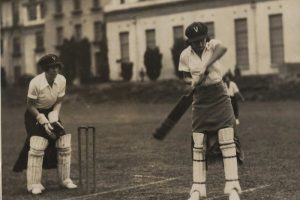 Australia took things forward by creating a league in 1894. It was the brainchild of Lily Poulett-Haris, a Tasmanian who captained the Oyster Cove team in the league. Her team was one of the first to be formed Down Under.
Australia took things forward by creating a league in 1894. It was the brainchild of Lily Poulett-Haris, a Tasmanian who captained the Oyster Cove team in the league. Her team was one of the first to be formed Down Under.
Bu there was no appreciation for the ladies playing the game. As observed by Isabelle Duncan in her book Skirting The Boundary, “Women were practically locked up behind high walls at school, cricket wasn’t considered becoming for a lady, and the industrial revolution put a stop to the game among the working classes, because they were too tired to play. Everybody became prudish and it went completely backwards. There were still some very talented women, like WG Grace’s daughter, Betty, but then he himself stopped her playing.”
Though being disrespected for playing cricket, still the leading women in cricket kept the game alive among them. The English Women’s Cricket Association was founded in 1926. England went for their 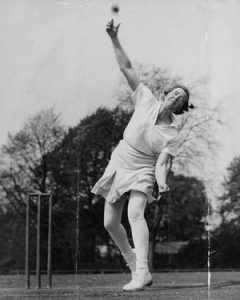 first international tour to Australia in 1934–35. The first Women’s Test Match was played between England and Australia in December 1934. Myrtle Maclagan, the opening batter for England who was also a spin bowler, took 7 wickets for 10 runs against Australia in the first innings of the first match in Brisbane. She finished the three-match series with 253 runs and 20 wickets, inspiring the conservative Morning Post to acknowledge her achievement through the following poetry:
first international tour to Australia in 1934–35. The first Women’s Test Match was played between England and Australia in December 1934. Myrtle Maclagan, the opening batter for England who was also a spin bowler, took 7 wickets for 10 runs against Australia in the first innings of the first match in Brisbane. She finished the three-match series with 253 runs and 20 wickets, inspiring the conservative Morning Post to acknowledge her achievement through the following poetry:
“What matter that we lost, mere nervy men/Since England’s women now play England’s game?
Wherefore, immortal Wisden, take your pen/ And write MACLAGAN on the scroll of fame.”
But acknowledgements kept aside, the women players had nothing else to cheer about. The women’s game was to rely heavily on individual contributions. In the 1960s Enid Bakewell, one of the greatest all-rounders the game has produced, was seen selling chocolate on the boundary at Trent Bridge to raise money. But the love for the game kept them afloat.
The International Women’s Cricket Council was formed in 1958 to unify women’s cricket in Australia, England, New Zealand, South Africa, the West Indies, Denmark and the Netherlands. During this time, India took their first step into the arena. Though women played cricket in various places in the early 70’s but officially it started with the registration of Women’s Cricket Association under the founder secretary Mahendra Kumar Sharma.
While in India cricket was taking baby steps, in England, Rachael Heyhoe Flint, 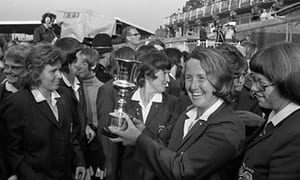 who made a record 51 appearances for England in all forms of the game, was taking cricket to the next level. Unbeaten in Tests in her 12-year reign, Flint was tireless in promoting the cause of the women’s game. It was she who sowed the seeds for the advent of the Women’s World Cup. With the help of Wolverhampton businessman Jack Hayward, Flint was successful in not only organizing the first World Cup but also leading England to victory. But the most interesting fact is that the event was organized in 1973, two years before the advent of Men’s World Cup.
who made a record 51 appearances for England in all forms of the game, was taking cricket to the next level. Unbeaten in Tests in her 12-year reign, Flint was tireless in promoting the cause of the women’s game. It was she who sowed the seeds for the advent of the Women’s World Cup. With the help of Wolverhampton businessman Jack Hayward, Flint was successful in not only organizing the first World Cup but also leading England to victory. But the most interesting fact is that the event was organized in 1973, two years before the advent of Men’s World Cup.
The curator of Bowral Bradman Museum, David Wells once said, “It’s interesting how many firsts are associated in cricket with the women’s game and one of them is that women invented round-arm bowling.” A woman by the name of Christina Wiles, of Kent, who used to play with her brother John started to deliver the ball from waist-high simply because her hooped skirt made it impossible for her to bowl the ball underarm. Her style later came to be known as “round-arm bowling” and was the precursor of the overarm bowling that exists today.
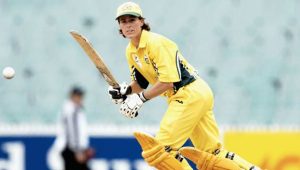 Wells further said that while cricket had often been viewed as a male dominated sport, it was the men who had followed in the footsteps of the females. It was in 1958 that Australian cricketer Betty Wilson made history as the first player for both genders to make a century in Test while also taking 10 wickets in the same test. Another 40 years after this, Belinda Clark, one of the greatest Australian cricketer, became the first player to score 200 runs in a one-day international when she scored the highest individual score of 229* against Denmark in Mumbai in 1997 Women’s Cricket World Cup. Pakistan’s Sajjida Shah is the youngest player to appear in international cricket, playing against Ireland at the age of 12. She also holds the record for the best bowling figures in a one-day international, taking 7 wickets for just 4 runs against Japan in Amsterdam in 2003. Even the first T20 international match was played between two women teams when England took on New Zealand at Hove in 2004, almost 1 year before the male debuted in the format.
Wells further said that while cricket had often been viewed as a male dominated sport, it was the men who had followed in the footsteps of the females. It was in 1958 that Australian cricketer Betty Wilson made history as the first player for both genders to make a century in Test while also taking 10 wickets in the same test. Another 40 years after this, Belinda Clark, one of the greatest Australian cricketer, became the first player to score 200 runs in a one-day international when she scored the highest individual score of 229* against Denmark in Mumbai in 1997 Women’s Cricket World Cup. Pakistan’s Sajjida Shah is the youngest player to appear in international cricket, playing against Ireland at the age of 12. She also holds the record for the best bowling figures in a one-day international, taking 7 wickets for just 4 runs against Japan in Amsterdam in 2003. Even the first T20 international match was played between two women teams when England took on New Zealand at Hove in 2004, almost 1 year before the male debuted in the format.
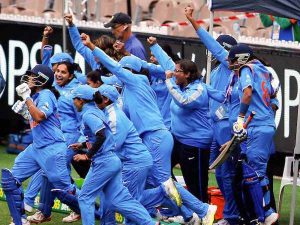 From a very humble beginning, women’s cricket has walked a long way. The game certainly received the much-needed fillip due to the World Cup. Until 2000, it was administered by International Women’s Cricket Council. But from 2005 when the body merged with International Cricket Council, the Women’s World Cup came under the umbrella of ICC. The scenario is changing for the women cricketers. From the late 18th century, when ladies made their first mark on cricket amid frantic betting and rowdy crowds, passing the highs and lows of the 19th and 20th centuries, Women’s Cricket has culminated in being a professional sport with some nerve-wrecking heroics from dominating cricketers.
From a very humble beginning, women’s cricket has walked a long way. The game certainly received the much-needed fillip due to the World Cup. Until 2000, it was administered by International Women’s Cricket Council. But from 2005 when the body merged with International Cricket Council, the Women’s World Cup came under the umbrella of ICC. The scenario is changing for the women cricketers. From the late 18th century, when ladies made their first mark on cricket amid frantic betting and rowdy crowds, passing the highs and lows of the 19th and 20th centuries, Women’s Cricket has culminated in being a professional sport with some nerve-wrecking heroics from dominating cricketers.

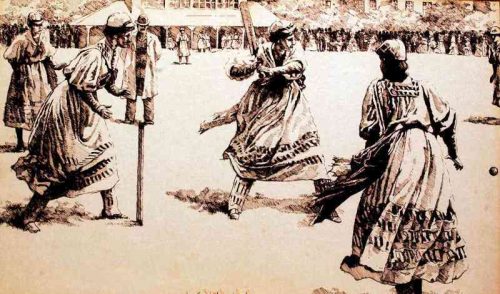



Badiya story
Excellent and virgin content on this site. One of a kind sports website which showcase sports talents. Great initiative and keep up the good job…
Hey! Wonderful piece of writing! I prefer strategy that you explained Women’s Cricket-The
History From Frantic Betting to Fan Following.
I actually quote this author supplies significant example of publishing and high writing skills.
Hey there! Excellent statement! I find nice how you illustrated Women’s Cricket-The History From Frantic Betting to Fan Following.
An additional wonderful summary by very good blogger.
Hey all! Fantastic content! I really like the
strategy by which you defined Women’s Cricket-The History From Frantic Betting to
Fan Following. It’s actually a good piece of content .
Good day! Terrific piece of writing! I prefer how well you outlined Women’s Cricket-The History From Frantic
Betting to Fan Following. Very good activity, mate. I normally value people that are capable of content.